[Weekender] Hidden hot spots in Seoul
Art, cafes, shops, ambience attract young people
By Ahn Sung-miPublished : June 26, 2015 - 18:53
While places like Myeong-dong, Garosu-gil and Hongdae are still popular meeting spots where both Seoulites and tourists flock, in recent years, a slew of new hot spots have sprung up, grabbing attention of those wanting something different.
These lesser-known districts are smaller than the mainstream hangouts. Yet, they boast unique, chic and sometimes kitsch ambiences that are not easily found at the usual nightspots saturated with big name chains.
These up-and-coming neighborhoods can be difficult to navigate, especially for first timers. However, venturing out into the labyrinth of alleys in search of hidden gems of the city can be exhilarating.
The Korea Herald introduces some of the fledgling neighborhoods in the city. Discover each hidden spot before the alleyways become too gentrified or popular.
These lesser-known districts are smaller than the mainstream hangouts. Yet, they boast unique, chic and sometimes kitsch ambiences that are not easily found at the usual nightspots saturated with big name chains.
These up-and-coming neighborhoods can be difficult to navigate, especially for first timers. However, venturing out into the labyrinth of alleys in search of hidden gems of the city can be exhilarating.
The Korea Herald introduces some of the fledgling neighborhoods in the city. Discover each hidden spot before the alleyways become too gentrified or popular.
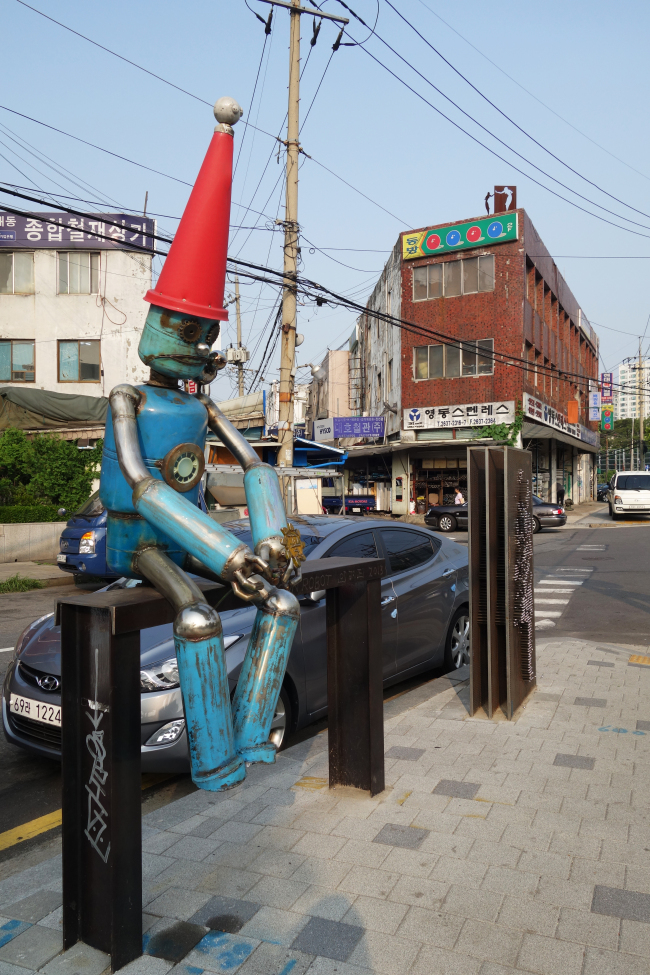
Mullae Art Village
Take a quick glance at Mullae-dong, and all you see are iron bars, slabs and panels and workers busy cutting and welding them.
But when looking above and between the factories, there is something more than the colorless metals in every nook and cranny. On the narrow alleyways between the factories, vibrant murals and statues add color, newly-opened restaurants and cafes add fresh life to a once declining area.
Many artists were searching for new places to reside and work, fleeing the gentrified, commercialized Hongdae district ― which used to be a haven for creative and free minds. In search of more affordable studios, Mullae-dong became a popular destination.
Mullae-dong, now, boasts the coexistence of artists and engineers ― where iron welding takes place on the first floor of factories and more artistic craftsmanship happens on the second floor.
How to get there: Take Exit 7 from Mullae Station, Line 2, and walk straight for 200 meters until you arrive at the junction of Dangsan-ro and Dorim-ro 128-gil. At the junction, you will find the sign marking the entrance of the Mullae Art Village.
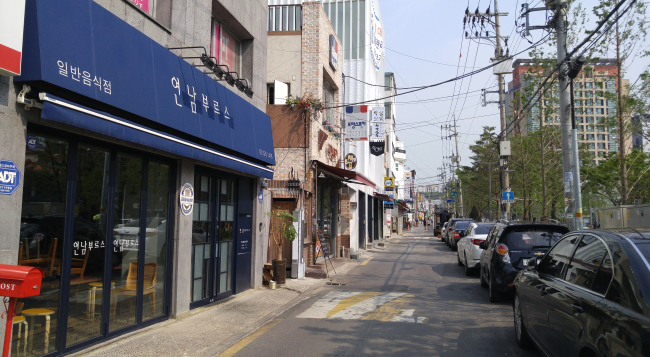
Yeonhui-dong and Yeonnam-dong
One thing apparent when strolling around Yeonhui-dong and Yeonnam-dong ― two neighborhoods just a short walk away from the hustle bustle of Hongdae ― is the plethora of authentic Chinese restaurants nestled in the district.
Yeonhui-dong has been an enclave for ethnic Chinese living in Korea, better known here as “hwagyo,” since the 1970s.
Hwagyo’s prevalence of the area is palpable, with a wide array of Chinese eateries ― from high-end seafood restaurants to humble noodle and dumpling shops ― populated in the neighborhood.
Beside Chinese foods, there are plenty of trendy cafes, boutique shops and galleries, which are all proof that this is Seoul’s rising, or perhaps already risen hot spot.
While Yeonhui-dong boasts more refined, modernized and bigger restaurants and upmarket stores, Yeonnam-dong is quaint and less sophisticated, reminding people of what Seoul’s small residential neighborhood was like during the 1980s, before high-rises dominated Seoul’s skyline.
It’s a rare mix of residential and commercial areas, where visitors can sip a cup of tea while watching children hang out at the playground.
How to get there: From Hongdae Station, Line 2, Exit 3, walk straight on Yeonnam-ro until the intersection with Seongmisan-ro. Turn right and walk straight. The general neighborhood on the Seongmisan-ro is Yeonnam-dong. Yeonhui-dong is to the north of Yeonnam-dong.
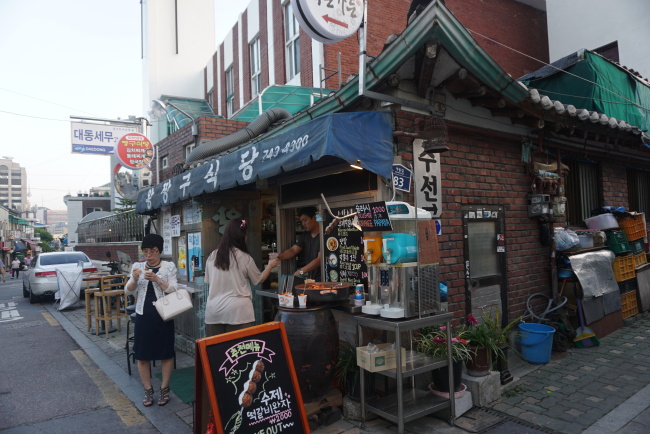
Gyedong-gil
Gyedong-gil is a 500-meter-long alleyway, which is part of the larger Bukchon Hanok Village, a home to some 900 hanok, traditional Korean housing.
There are many restaurants, galleries and shops housed in hanok and other old buildings along the streets.
It’s a network of alleys where old meets new, tradition meets modern and the nutty flavor of sesame oil looms thick in the air while hand-tossed pizza is baked in wood-fired ovens. Residents walk along hanok-lined streets while visitors indulge in street foods and shop for souvenirs.
The city-run Bukchon Cultural Center offers both locals and foreigners cultural programs, lectures and classes in a traditional hanok atmosphere.
The prestigious Choong Ang High School marks the end of Gyedong-gil. The school’s beautiful Gothic stone building is not only known for its long history of eight decades, but also as one of the filming location for the hit Korean drama “Winter Sonata” in 2002. Overseas drama fans make a pilgrimage to the school’s gate and take pictures. There are even two small souvenir stores beside the entrance selling K-pop paraphernalia.
How to get there: Get off at Anguk Station, Line 3, Exit 3. Walk straight and on the first boulevard, turn left onto Gyedong-gil.
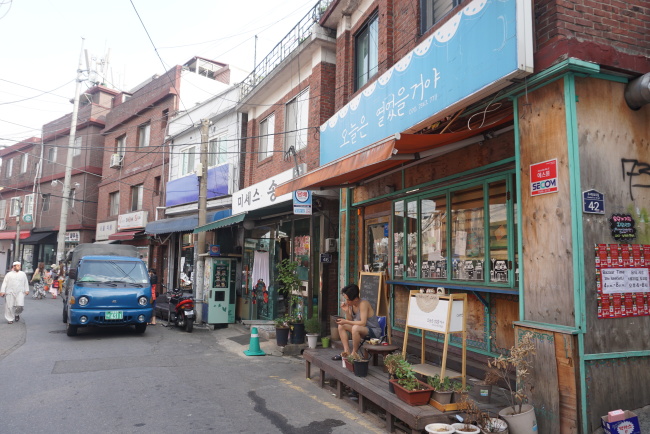
Usadan Village
Usadan Village is a small area encircling Usadan-ro 10-gil in Itaewon ― where Seoul Central Mosque stands ― and a slew of stores and ateliers around the neighborhood. The village was more known as a shanty town subject to a long-stalled redevelopment plan until few years ago, when a number of artists arrived in the area in search of cheaper, low-key properties.
Now, the demographic of the village is an interesting blend of Muslims who visit the mosque for their weekly prayer known as Jummah, locals who have lived there for decades, bohemian artists with their own design studios, flower shops and ateliers, and tourists looking for something exotic.
The 500-meter-long alleyway ― stretching from Seoul Central Mosque to the Dokkebi market at the end of the street ― is filled with two- and three-story stained concrete buildings that house both old-fashioned stores with faded signboards and polished establishments such as organic juice bars, takeout coffee shops and even a tattoo parlor. The street is a fusion of old and new, reflecting the rapidly changing Seoul in a snapshot.
Go to Usadan Village on the last Saturday of every month to get a glimpse of the Stairway Flea Market. The store owners and artists in the city turn into vendors selling anything to everything from leather goods to locally farmed honey, barbecue sandwiches and T-shirts.
How to get there: From Exit 3 at Itaewon Station, Line 6, walk straight and take a right before the Itaewon Fire Station. Go up the hilly street and take a left at the Bogwang Elementary School Intersection and walk straight for another 100 meters.

Seongsu-dong
Recently dubbed Seoul’s Brooklyn, Seongsu-dong was far from anything sophisticated. The working-class neighborhood beside the Hangang River was home to small and medium-sized redbrick factories, gray warehouses, car repair shops and shoe manufacturers ― with the smell of leather filling the area.
Now, the area welcomes weekly fashion events at the warehouses, which have been turned into art spaces, and trendy people strolling the street. It all began around 2011, when artists and designers moved to Seongsu-dong, attracted by the low rents and the peculiar ambience of the area. A number of renowned designers, including Song Zio of his eponymous menswear brand and Lee Bo-hyun of shoe brand Suecomma Bonnie, opened their studios here as well.
With influx of artists, modern coffee shops, bars and restaurants have sprung up throughout the neighborhood. Yet, amid the contemporary additions, Seongsu-dong is still the same old neighborhood with factories nestled in the residential area, which perhaps gives the place its charm.
How to get there: Famous shops and restaurants are spread out between Ttukseom Station and Seongsu Station on Subway Line 2. For the first part of the cluster, get off at Exit 8 of Ttukseom Station, walk straight and cross the street. Behind the main street, there are number of alleys that house restaurants and cafes. For the second cluster of shops, take Exit 3 at Seongsu Station. Walk straight along the main street, where you will find shoe stores and factory-turned-art spaces.
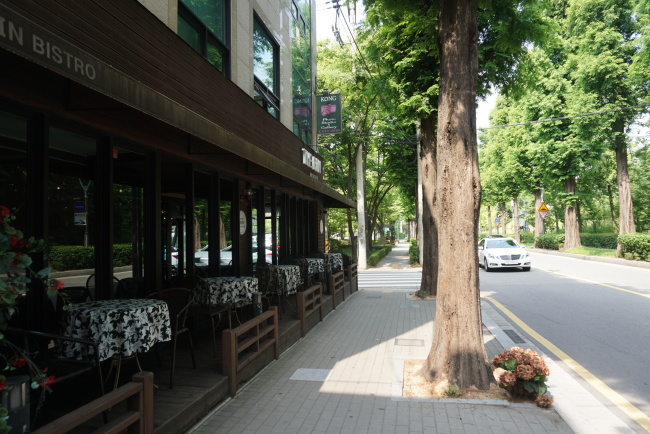
Yangjaecheon Ttukbang-gil
In recent years, French bistro, modern coffee shops, Japanese izakayas and antique stores have opened up on the street facing the Yangjaecheon Stream, one of the breach streams of the Hangang River, in Seoul’s glitzy Gangnam district.
These trendy restaurants with terraces stand on the street of Yangjaecheon-ro, better known as Ttukbang-gil, which means a path along the bank.
The secluded, upmarket restaurants attract dinner crowds seeking to pair several dishes with drink and especially couples on a date looking for less-crowded, romantic and tasty offerings.
The perk of this small yet posh area is its vicinity to the Yangjaecheon Stream Trail, the serene walking path along the banks of the stream.
Visitors can enjoy blooming cherry blossoms in the spring, the taste of lush greenery during the summer, red and yellow leaves in the fall and snow-capped streams in the winter.
How to get there: From Maebong Station, Line 3, Exit 4, walk straight and turn left at the intersection with Nambusunhwan-ro 37-gil. Walk straight and turn right at the end of the three-way street, where it meets Yangjaecheon-ro.
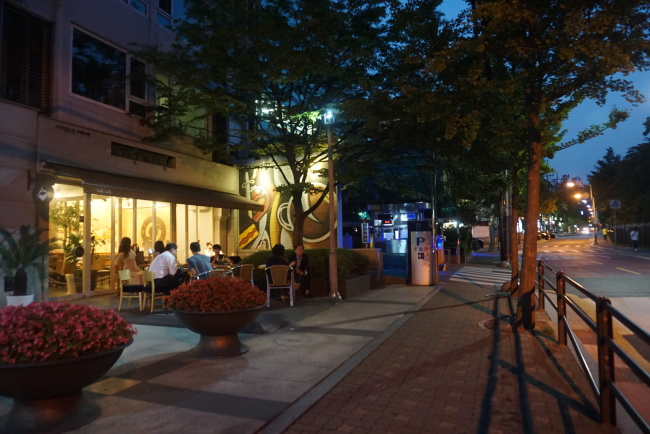
Samseong-dong Deunggiso-gil
Tucked a couple of blocks away from the skyscraper-studded Teheran-ro, Deunggiso-gil is one of the rising after-work hot spots in Seoul’s upscale Gangnam district.
The official name of the street is Bongeunsa-ro 68-gil. But it is better known here as Deunggiso-gil, named after Gangnam Deunggiso (registry office), which used to stand on the street, but is no longer there.
The street surrounds the large Seonjeongneung, the burial ground of two Joseon era Kings and one queen that is designated part of a UNESCO World Heritage site. The wide, verdant green space invites nearby office workers and local residents to take a stroll around the royal tomb.
From posh Italian restaurants, American pubs to humble Korean restaurants, the area’s chilled yet savvy ambience serve as the ideal spot for workday lunches and also the after-work hangouts. The street also houses design studios and galleries, adding more aesthetic scenes and unique architectures to the area.
How to get there: From Samseongjungang Station, Line 9, Exit 7, walk straight for 300 meters until the intersection with Bongeunsa-ro 68-gil. Restaurants and shops are located on the road.
By Ahn Sung-mi (sahn@heraldcorp.com)







![[KH Explains] Hyundai's full hybrid edge to pay off amid slow transition to pure EVs](http://res.heraldm.com/phpwas/restmb_idxmake.php?idx=644&simg=/content/image/2024/04/18/20240418050645_0.jpg&u=20240419100350)







![[From the Scene] Monks, Buddhists hail return of remains of Buddhas](http://res.heraldm.com/phpwas/restmb_idxmake.php?idx=652&simg=/content/image/2024/04/19/20240419050617_0.jpg&u=20240419175937)

![[KH Explains] Hyundai's full hybrid edge to pay off amid slow transition to pure EVs](http://res.heraldm.com/phpwas/restmb_idxmake.php?idx=652&simg=/content/image/2024/04/18/20240418050645_0.jpg&u=20240419100350)

![[Today’s K-pop] Illit drops debut single remix](http://res.heraldm.com/phpwas/restmb_idxmake.php?idx=642&simg=/content/image/2024/04/19/20240419050612_0.jpg&u=)